I know you wonder what on earth I wear out there with the bees.
Here it is. Cute, but hot.
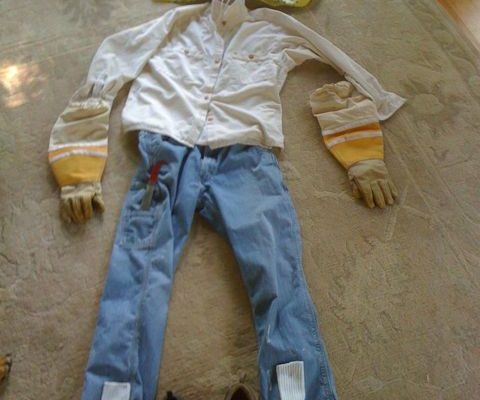
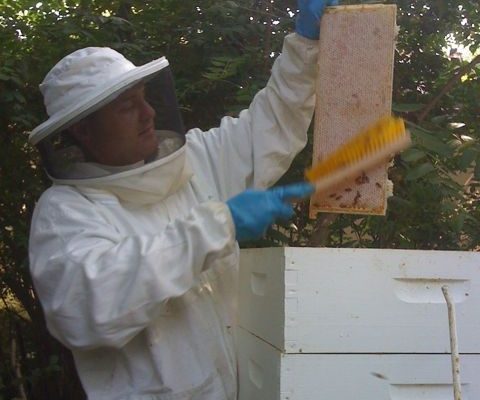
Jim’s bees made him some beautiful honey this year, and yesterday he made a little party out of harvesting it.
I helped pull honey from the supers…it was only around 96 degrees out there! Actually, the fact that the honey was so danged warm made it easier to extract (and, oh my gosh…you should taste warm honey straight from the hive. To. Die. For).
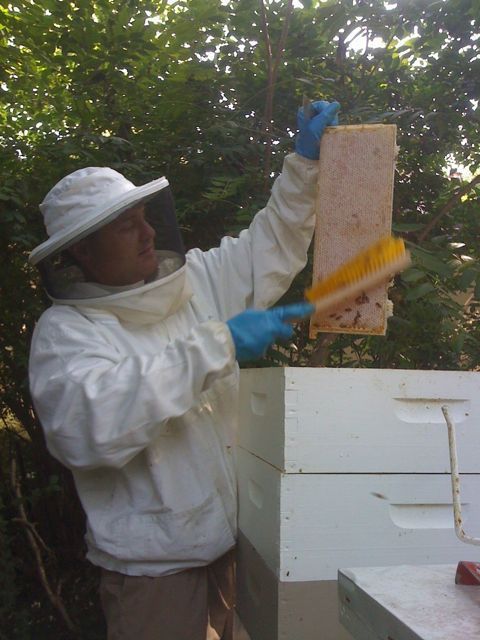
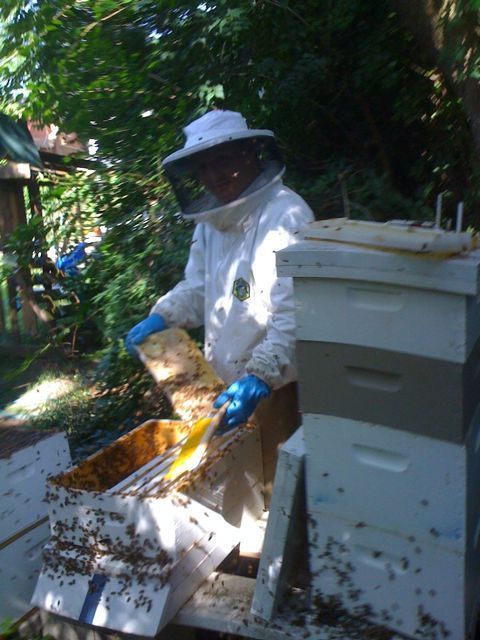
Then we picked up Christy and all her harvesting equipment. Christy lives and keeps her hive about two blocks away from Jim…she inherited and then refurbished an extractor made in the 1800s. In the 1800s, lids for extractors must have been considered sissified, so we ended up covered in a little glorious mist of honey.
Jim set up his honey shop in his basement laundry room. First, Jim decapped the honey by either scraping or by using a hot decapping knife. I prefer the scraper…it’s simpler, and when it comes to bees, I like it simple.
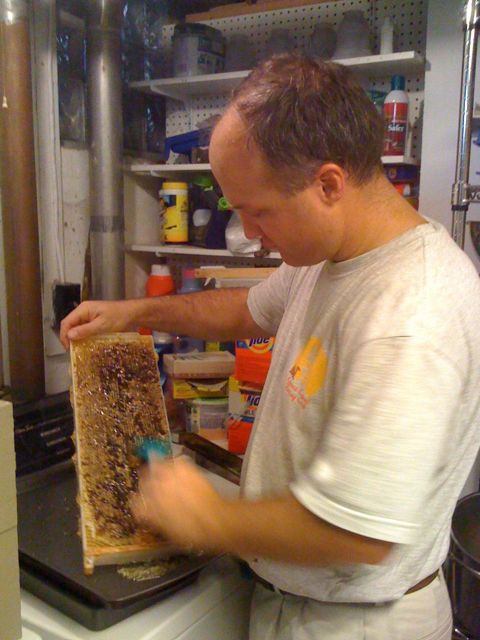
We all took our turns doing all the jobs. Here, Christy takes the first turns of her ancient-but-perfectly-workable extractor.
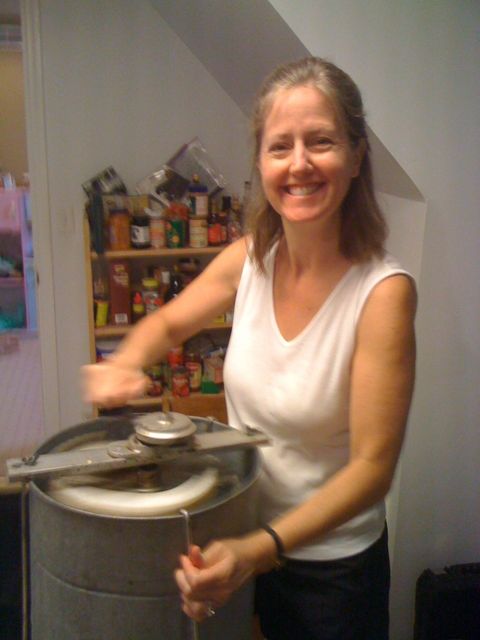
Jim and Jennifer invited other friends over, too. And Jennifer made BLTs. I mean, how absolutely wonderful is a house filled with friends and with the smells of both warm honey and BLTs?—Heaven.

When Jonathan said he wanted to take his turn with the extractor, Jim beamed (that’s funny!)…he said he’d dreamed of this day. Thanks for sharing the dream, Jim.
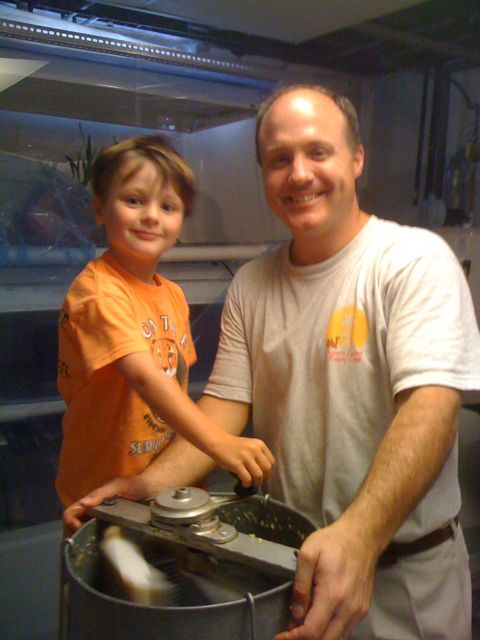
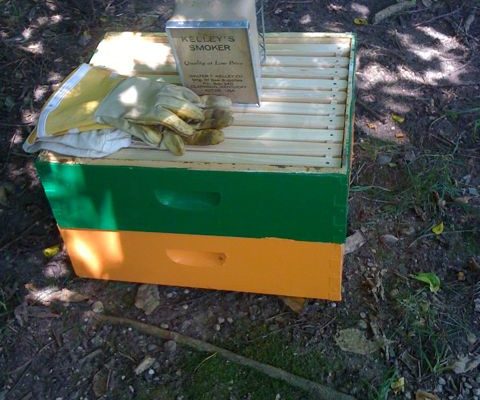
Success!
Yesterday I inserted a box I fashioned from two shallows between my two brood boxes in Girls of Summer. They’re the most robust of our colonies, and they’ve been mighty crowded and hot and bearding like crazy.
So, I pulled deep frames of brood up from the bottom box and into the center of the new box; I interspersed medium, undrawn foundationless frames among all the fully drawn comb in the bottom two boxes. Then, I restacked them. This should give them the room they need to operate.
Yep, I’ve got a real mishmash of frames going on in there now, and there’s quite a bit of empty space that the bees will surely fill up with wild comb, but I guess I can figure out how to deal with all of it later.
My goals:
So, now that I know this addition of space and new frames has stopped the bearding in Girls of Summer, I need to do the same thing for Amazons and Tomboys. Which means I’ve got to head down into the basement and make 20 frames today.
Here are some pictures. They don’t show you much other than what it looks like to rearrange a bee colony.
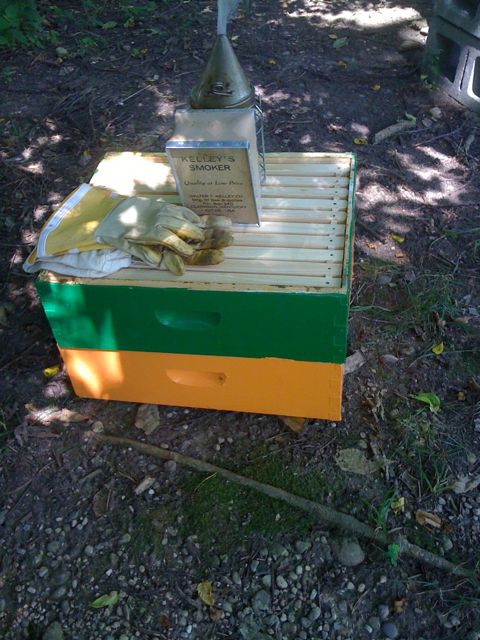
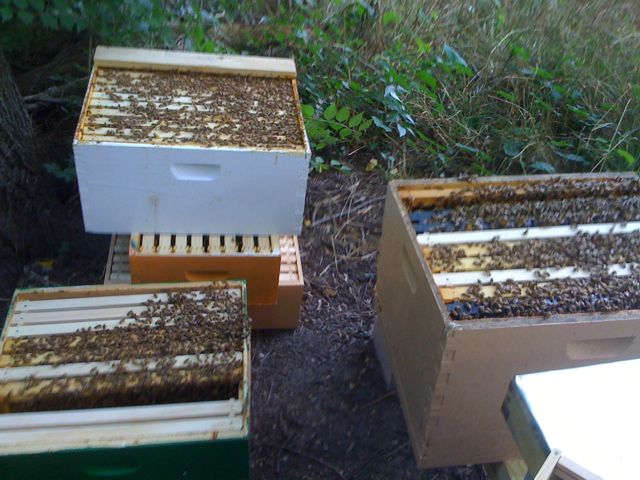

Those bees are bearding like crazy. Which means they are hot and crowded. But they won’t move up into the new supers I’ve added in order to give them some extra room. And yesterday I found swarm cells in Tomboys again. Shit.
I would normally add an empty box below one of the brood boxes in each colony, but I’m trying to transition from using 10-frame deep boxes to 8-frame medium boxes…I won’t go into it here because it’s so danged confusing, but this translates into some tricky box and frame configurations.
Yesterday the light came on in my brain about this. Of course, the light went on about two hours after I’d inspected the bees…which means I get to go out there and do it again today.
Here’s my plan: I stacked together two shallow supers (to form one box) and filled them with 10 medium, foundationless frames. Today, I’ll insert the two-shallow unit between the deep brood boxes in Girls of Summer. This way, they’ll have room to work and frames on which to draw comb in which the queen can lay eggs. AND, because these are medium depth frames, once they’re drawn, I can eventually move them into my 8-frame medium boxes.
I hope this works. I’m proud of myself for thinking outside of the box about this stuff.
Yes, the bees will most likely build some funky comb in the gap that shouldn’t be there…between the bottom of the frames in the two-shallow box and the top of the deep brood box. But I guess I can cut that excess comb off and tie it into it’s own frame later. Which means that I’ll get a lot of bang for my buck if they draw comb below these new frames.
I’ll need to move some already filled deep frames containing brood into the two-shallow box in order to encourage the bees to move up. This interspersing of differently sized frames is going to make for a very very interesting situation when I dig in there next spring.
I have two concerns: first, that they won’t draw any comb whatsoever and that they’ll still feel crowded; and second, that I’ll forget that I experimented this way and I’ll have a real mess on my hands when I unsuspectingly discover the interspersed medium and deep frames and the medium frames with that huge gap beneath them.
One reason I’m posting some of this dull information is so I can refer back to them later…so I’m not surprised (more than usual) during my inspections—or, if I am surprised, I can refer to these posts and see what on earth I was thinking.
I TRIED to take pictures for you yesterday, but that dang iPhone just will not respond to my gloved fingers. I got the phone all gooped up with propolis before I decided I just couldn’t spend the time taking the pictures for you. Sorry. I have to work at a better system and use another camera.
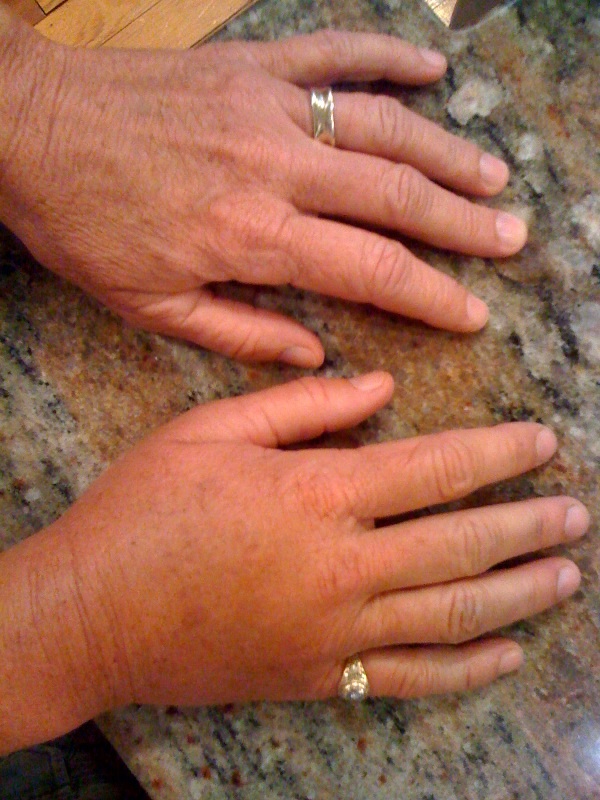
Deb got stung by one of her uncle Doyle’s bees.
We spent a couple of days on the farm in Waco, Kentucky; and when we visited with her uncle Doyle, we all went out to look at his bees. He has only one hive now, but it’s stacked with six honey supers…it’s tall, and you can’t believe my envy.
The bees sort of gave us a warning that we were too close, so we moved back a little bit. But then Deb got stung. And while her uncle Doyle looked through his pocket for his knife with which to scrape the stinger out, Deb pulled it out. I think that’s why she swelled so badly.
Here’s the rule of thumb: When you get stung, don’t pull the stinger out…scrape it off. When you pull a stinger from your skin, you milk MORE venom into your bloodstream. That whole stinger is loaded with bee venom and it’s designed to pulsate poison long after the bee is gone…if you can keep your wits about you, try to grab either a pocket knife, or a hive tool, or a credit card, or something with a sharp edge to it…a good fingernail will do. Then scrape the stinger off where it enters your skin. This way, the venom stays in the stinger and not in you.
Deb will not be golfing today—her hand won’t grip the club. And after icing it all the way home and taking two Aleve, a couple of Benadryl, and some Tagamet (all antihistamines of sorts) she may not wake up today, either.

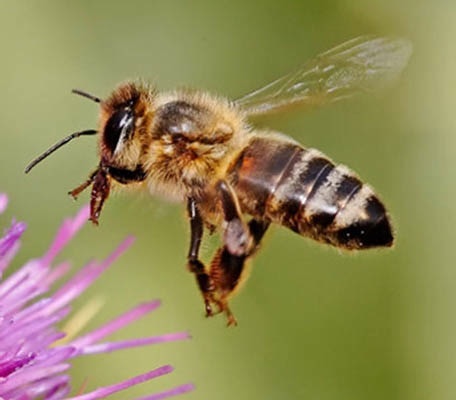
I put my name out on the internet as a honeybee-swarm collector, and I’ve been getting tons of calls to remove bees from structures…like log cabins, etc. Every day someone calls about bees.
I want to collect swarms, but I don’t do “cut outs.”
However, this morning I got a call from our friend, Don, who said his neighbor had found honeybees building comb in his birdhouse, and I was elated. I am dying to increase my colonies with local, feral bees. They’re healthier. And they’re free. And it’s cool to have them.
So tonight I loaded my car with all the equipment I thought I could possibly need to capture bees from the birdhouse. I mean, I had it all in there. I fired up my smoker and drove to the Korengel’s house with my smoker blowing smoke out the open windows and visions of strong and feral bees coming home with me and building comb and making me some honey. I was thinking of myself as a big bee expert.
But when I got to the birdhouse, I realized that those weren’t honeybees; they were yellow jackets. Shit. I told Don to tell his neighbor to kill them.

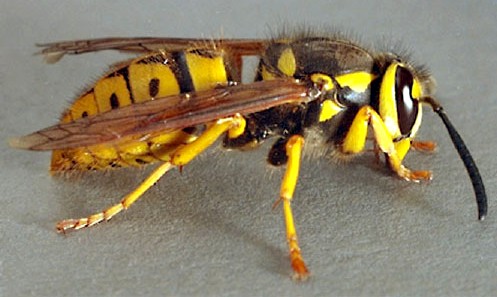
I discovered a couple of swarm cells in Tomboys before I left for Florida last week. I thought for sure Tomboys would swarm before I returned, and they may have…hard to tell.
Today the swarm cells were still there, so in order to keep the bees from swarming and to take advantage of the new queen cells, I used the swarm cells from Tomboys to make a split and create a new hive.
(I KNOW…I should have taken more pictures, but here’s the problem: My iPhone operates by touch, and my gloves aren’t exactly like skin, so in order to use the iPhone for pictures, I have to take off my glove, take the picture, put the glove back on, etc. Time consuming and awkward.)
Anyway, I took Michael Bush’s advice from Beemaster.com: I stacked two medium boxes together; in the center of the top box, I put 4 deep frames (one containing the swarm cells [these will supply the queen], one containing honey [this will supply food until there are active foragers] two containing brood [these will build up the colony with workers]; I filled the remainder of the boxes with empty, medium-depth, foundationless frames. The bees will certainly build some funky comb beneath the deep frames because there’s so much empty space there, but I can clean that mess up later.
I scooted Tomboys over a little bit, and I placed the new, as-yet-unnamed hive facing the entrance of where Tomboys previously sat. The foragers who left Tomboys this morning (before the move) should be confused as to which hive they belong when they return—50% should enter the new hive and build up the population there; 50% of them should head back into their Tomboys home. I’ll to reverse the two hives in 7 days to balance it all out.
I don’t know if I should name the new hive yet or not. This thing feels quite experimental, so I don’t want to pin any hopes on its survival.
Here’s what the set up looks like now:
On another note: Girls of Summer are building great comb on their new foundationless frames. Neither Amazons nor Tomboys are doing a thing with theirs yet…but I think each of those hives is trying to build up post swarming, so they aren’t drawing any comb whatsoever.
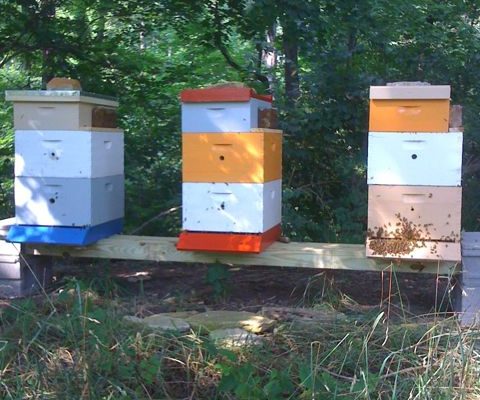
Gosh darn crazy bees are driving me nuts.
I decided to begin my transition from 10-frame deep and shallow boxes to all 8-frame mediums, and I began the process today. I added a new smaller box to each of my three hives. Now they look a little bit lopsided and goofy, but transitions are tough, I tell you.
Anyway, as I was checking things out in the hives, I discovered a number of queen cells in Tomboys (yes, I should have taken a picture for you, but I forgot again). Crap. Which means I need to make a split of that hive or risk losing half its bees to the woods. But I’ve never split a hive before. I swear, I always have to do these things before I’m prepared…I haven’t though this situation out yet. Oh well. What do I have to lose, Reader, but a bunch of bees?
I’d better do it tomorrow or risk their swarming while I’m out of town.
So, as I understand it, to make a split I need to separate my current two deep brood boxes and create two separate hives from them…one hive will contain the queen cells, and the other hive (hopefully) contains the current queen. If something should happen to the queen or the queen cells as I’m making this split, the bees will probably rear another queen…so long as there are eggs and/or uncapped larvae in some of the frames.
I guess that’s my job for tomorrow. Split Tomboys into two hives and add another 8-frame medium super to one of the newly created colonies so they have room to grow. Before I know it, I’m gonna have yard full of beehives. Deb’s gonna kill me. She’s already very very worried about driving to the farm with one or two bee colonies in the back of the car.
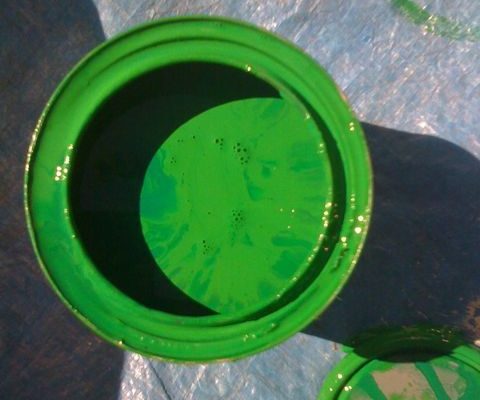
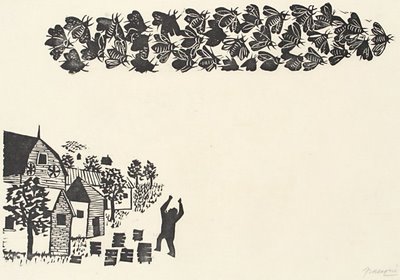
The minute I put that wax melter out in the sun, the sun disappeared. Then the temperatures dropped. And no wax on earth will melt at 70 degrees and under cloudy skies. So, we’ll try when the weather heats up again.
But doesn’t it feel great out there? Every single one of our windows is open, and I’m sitting here in a flannel shirt.
Which brings me to the solstice. Once the days begin to get shorter, the queen’s egg laying begins to slow, too. Which means that—even though it’ll still feel like summer around here for a few months—the hive begins to prepare for fall and winter. Conservation begins. Then, in January, when the winter solstice arrives and the days begin to be imperceptibly longer, and even though it feels as if the cold will never end and the earth will never thaw, the queen begins to gear up for egg laying again. She beings laying in earnest in February. The cycle of the hive is perfectly synced with the cycle of the sun.
No matter where you live or what your temperatures are like, your hive cycle depends not on temperature but on the length of the day.
And here’s what it feels like when your hive swarms in April, May, or June.

At first, I had this image filed under “Telling the Bees” because the beekeeper looks so distraught. Maybe that’s one reason I really love this piece…it fits many emotions.
